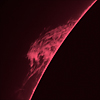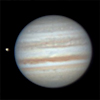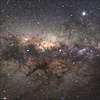 |
CHAMÄLEON + ONJALA OBSERVATORY DeepSky | SITEMAP HOME CHAMÄLEON |
|
 |
|||
| « back to overview Nebulae | Load higher resolution (1800 x 1500 Pixel 3500 x 3100 Pixel) | Object description |

NGC 3532
is a large and bright open star cluster in the constellation Carina (keel of the ship). With an apparent brightness of the 3rd magnitude it is already clearly visible to the naked eye. It is located just 3 degrees east of the large Eta Carina nebula complex (NGC 3372) and covers an area twice the size of the full moon when viewed with the naked eye. In the english-speaking world, it also has the informal name "Wishing Well Cluster", as it reminds one of the bottom of a coin-covered fountain sparkling in the sunlight. Because of its elongated shape, it is also known as a "football cluster".
NGC 5332 is a cluster of about 400 stars and an estimated age of 300 million years. According to Trumpler it is catalogued as type II 1 m, its distance to the solar system is estimated to be 1500 to 1600 light years. With an age of 300 million years NGC 3532 belongs to a middle-aged star cluster. Those stars that started with moderate masses still glow brightly in blue-white colors, but the more massive stars have used up their hydrogen supplies and have evolved into red giants. Therefore the star cluster contains both blue and orange colored stars in abundance. The most massive stars will have already gone through their short lives and ended long ago in supernova explosions. Northwest of NGC 3532, dark nebulae in front of the cloud obscure the light of the stars in the background.
East of NGC 3532 is a faint diffuse nebula region GN 11.09.9.02 with an apparent size of about 10 archminute diameter. South of the star cluster lies the large and very faint H-II nebula region GN 11.01.1. The whole region seems to be covered by very faint blue reflection nebulae, especially prominent southeast of NGC 3532.
 |
The
star cluster was discovered in 1751 by the French astronomer Nicolas Louis de
Lacaille and catalogued by him in 1755. More objects in our picture: Stock 13 is a small open star cluster with an apparent diameter of only 3 arc minutes. According to Trumpler it is classified as type I 3 p n. Its age is estimated at 25 million years, its distance to the Sun is about 9000 light years. Prof. Dr. Jürgen Stock was a German astronomer who emigrated to the USA after World War II. Stock was a specialist for Seeing Site Test measurements and researched open star clusters. His catalogue contains 24 objects. After many years of Seeing Site Test measurements in the Chilean Andes, he determines the site for the large Cerro Tololo Inter-American Observatory (CTIO). The large ESO centre was later built nearby. Stock later moved to Venezuela and became director of the CIDA (Centro de Investigaciones de Astronomia). Jürgen Stock died in 2004. « The annotated image shows the size comparison with the moon. |
Trumpler 17 is a small open star cluster with an apparent diameter of only 5 arc minutes. It lies about 9000 light years away from the solar system, its age is estimated to be 25 million years.
NGC 3503/GN 10.59.2
NGC 3503 is a very young star cluster consisting of only about 10 stars. These stars are embedded in a very faint blue reflection nebula (GN 10.59.2). NGC 3503 is associated with the very small open star cluster Pismis 17 (reddish spot north (above) of NGC 3503). The stars of NGC 3503 are probably only 1 million years old, the region is about 14 000 light years away from the solar system.
Also marked in the image is a ring of brighter, blue stars with an apparent diameter of 30 arc minutes - named "Feinstein 1". Brightness measurements and spectroscopic investigations from 1964 indicate that this object is not a physical open star cluster. Some of these stars are located at a distance of about 1300 light-years from the Solar System, while another part is much further away at just under 4000 light-years. Alejandro Feinstein was an Argentinean astronomer at the Observatorio Astronomico in La Plata. A publication about Feinstein 1 can be found at the following URL.
Gum 34a (GN 10.56.0.02) is a faint H-II region arranged around the orange variable star U Carinae. U Carinae is a periodically variable star with an average brightness of 6.5 magnitude. The period is nearly 40 days.
Interesting in the context of our image is perhaps the fact that a section of NGC 3532 was selected as "first light" for the Hubble Space Telescope and showed the catastrophic imaging performance of the first Hubble optics in 1990.
 |
 |
 |
 |
 |
 |
 |
| Sun | Moon | Solar System | DeepSky | Widefield | Miscellaneous | Spec. Projects |